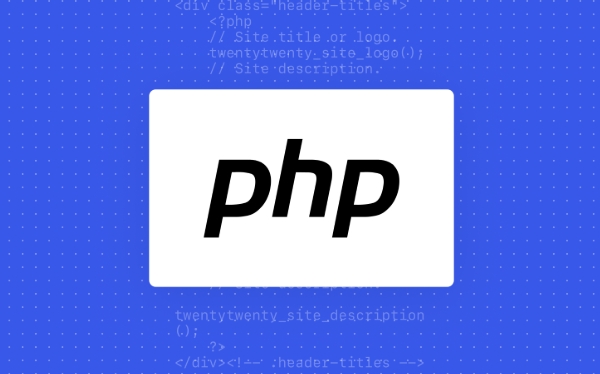PHP Explained: Server-Side Scripting Simplified
Jul 16, 2025 am 03:19 AMPHP is a server-side scripting language designed for web development. It runs on the server and after processing the code, it sends HTML and other content to the browser. Unlike client scripts (such as JavaScript), users cannot see the actual PHP code, only the output it generates. For example, PHP can connect to a database and display product lists dynamically. Reasons for PHP's popularity include: 1. Easy to learn; 2. Designed for web development; 3. Widely supported; 4. Having a large ecosystem; 5. Open source and flexible. PHP can be directly embedded in HTML files and run through local server environments (such as XAMPP). In short, PHP is a powerful tool for efficiently generating dynamic content.

PHP is a server-side scripting language designed for web development, but it can also be used as a general-purpose programming language. If you're new to PHP or looking to understand what makes it tick, the key idea is simple: PHP runs on the server, processes your code, and sends HTML (or other types of content) back to the browser.

What Exactly Is Server-Side Scripting?
Server-side scripting means that the code runs on the web server, not in the user's browser. When someone visits a webpage built with PHP, the server processes the PHP code first, executes any instructions (like fetching data from a database), and then sends the resulting HTML to the browser.
This is different from client-side scripting (like JavaScript), which runs after the page reaches the browser. With PHP, users never see the actual PHP code — only the output it generates.

For example:
- You have a PHP script that connects to a database and displays a list of products.
- The server runs this script when someone requests the page.
- It fetches product data, formats it into HTML, and sends that HTML to the visitor's browser.
Why Use PHP for Web Development?
There are several reasons why PHP has remained popular over the years:

- Easy to learn : PHP syntax is straightforward, especially if you already know a bit of C, Java, or JavaScript.
- Built for the web : PHP was created specifically for generating dynamic web pages, so it integrates smoothly with HTML.
- Widely supported : Most web hosting providers support PHP out of the box, making deployment easy.
- Large ecosystem : Popular tools like WordPress, Drupal, and Laravel are all powered by PHP.
- Open source : PHP is free to use and has a strong community contributing to its growth and documentation.
It's also flexible — you can write small scripts or build large applications using object-oriented programming and modern frameworks.
How Does PHP Fit Into a Web Page?
Let's say you're building a simple blog. Here's how PHP might come into play:
- A user visits
index.phpin their browser. - The server sees the
.phpextension and knows to run the PHP code inside the file. - That PHP code may connect to a MySQL database to retrieve recent blog posts.
- Once retrieved, PHP loops through the results and builds an HTML structure — maybe a list of post titles and excerpts.
- The final HTML is sent back to the browser, where the user sees the rendered blog homepage.
You can embed PHP directly into HTML files like this:
<!DOCTYPE html> <html> <body> <?php echo "Hello, world!"; ?> </body> </html>
When viewed in a browser, the user just sees “Hello, world!” — not the PHP code itself.
Setting Up a Basic PHP Environment
To start writing PHP, you need a few things:
- A text editor (like VS Code, Sublime Text, or even Notepad).
- A local server environment — options include XAMPP, WAMP, or MAMP.
- A browser to test your pages.
Once installed, place your .php files in the correct directory (like http://localhost/yourfile.php htdocs your browser.
If you're working on a live website, upload your PHP files to your web host via FTP or a control panel like cPanel.
That's the basic idea behind PHP and how it works on the server side. It's not magic — just a powerful tool that helps generate dynamic content efficiently.
The above is the detailed content of PHP Explained: Server-Side Scripting Simplified. For more information, please follow other related articles on the PHP Chinese website!

Hot AI Tools

Undress AI Tool
Undress images for free

Undresser.AI Undress
AI-powered app for creating realistic nude photos

AI Clothes Remover
Online AI tool for removing clothes from photos.

Clothoff.io
AI clothes remover

Video Face Swap
Swap faces in any video effortlessly with our completely free AI face swap tool!

Hot Article

Hot Tools

Notepad++7.3.1
Easy-to-use and free code editor

SublimeText3 Chinese version
Chinese version, very easy to use

Zend Studio 13.0.1
Powerful PHP integrated development environment

Dreamweaver CS6
Visual web development tools

SublimeText3 Mac version
God-level code editing software (SublimeText3)

Hot Topics
 1793
1793
 16
16
 1736
1736
 56
56
 1587
1587
 29
29
 267
267
 587
587
 Commenting Out Code in PHP
Jul 18, 2025 am 04:57 AM
Commenting Out Code in PHP
Jul 18, 2025 am 04:57 AM
There are three common methods for PHP comment code: 1. Use // or # to block one line of code, and it is recommended to use //; 2. Use /.../ to wrap code blocks with multiple lines, which cannot be nested but can be crossed; 3. Combination skills comments such as using /if(){}/ to control logic blocks, or to improve efficiency with editor shortcut keys, you should pay attention to closing symbols and avoid nesting when using them.
 Tips for Writing PHP Comments
Jul 18, 2025 am 04:51 AM
Tips for Writing PHP Comments
Jul 18, 2025 am 04:51 AM
The key to writing PHP comments is to clarify the purpose and specifications. Comments should explain "why" rather than "what was done", avoiding redundancy or too simplicity. 1. Use a unified format, such as docblock (/*/) for class and method descriptions to improve readability and tool compatibility; 2. Emphasize the reasons behind the logic, such as why JS jumps need to be output manually; 3. Add an overview description before complex code, describe the process in steps, and help understand the overall idea; 4. Use TODO and FIXME rationally to mark to-do items and problems to facilitate subsequent tracking and collaboration. Good annotations can reduce communication costs and improve code maintenance efficiency.
 Quick PHP Installation Tutorial
Jul 18, 2025 am 04:52 AM
Quick PHP Installation Tutorial
Jul 18, 2025 am 04:52 AM
ToinstallPHPquickly,useXAMPPonWindowsorHomebrewonmacOS.1.OnWindows,downloadandinstallXAMPP,selectcomponents,startApache,andplacefilesinhtdocs.2.Alternatively,manuallyinstallPHPfromphp.netandsetupaserverlikeApache.3.OnmacOS,installHomebrew,thenrun'bre
 Learning PHP: A Beginner's Guide
Jul 18, 2025 am 04:54 AM
Learning PHP: A Beginner's Guide
Jul 18, 2025 am 04:54 AM
TolearnPHPeffectively,startbysettingupalocalserverenvironmentusingtoolslikeXAMPPandacodeeditorlikeVSCode.1)InstallXAMPPforApache,MySQL,andPHP.2)Useacodeeditorforsyntaxsupport.3)TestyoursetupwithasimplePHPfile.Next,learnPHPbasicsincludingvariables,ech
 Improving Readability with Comments
Jul 18, 2025 am 04:46 AM
Improving Readability with Comments
Jul 18, 2025 am 04:46 AM
The key to writing good comments is to explain "why" rather than just "what was done" to improve the readability of the code. 1. Comments should explain logical reasons, such as considerations behind value selection or processing; 2. Use paragraph annotations for complex logic to summarize the overall idea of functions or algorithms; 3. Regularly maintain comments to ensure consistency with the code, avoid misleading, and delete outdated content if necessary; 4. Synchronously check comments when reviewing the code, and record public logic through documents to reduce the burden of code comments.
 Writing Effective PHP Comments
Jul 18, 2025 am 04:44 AM
Writing Effective PHP Comments
Jul 18, 2025 am 04:44 AM
Comments cannot be careless because they want to explain the reasons for the existence of the code rather than the functions, such as compatibility with old interfaces or third-party restrictions, otherwise people who read the code can only rely on guessing. The areas that must be commented include complex conditional judgments, special error handling logic, and temporary bypass restrictions. A more practical way to write comments is to select single-line comments or block comments based on the scene. Use document block comments to explain parameters and return values at the beginning of functions, classes, and files, and keep comments updated. For complex logic, you can add a line to the previous one to summarize the overall intention. At the same time, do not use comments to seal code, but use version control tools.
 Mastering PHP Block Comments
Jul 18, 2025 am 04:35 AM
Mastering PHP Block Comments
Jul 18, 2025 am 04:35 AM
PHPblockcommentsareusefulforwritingmulti-lineexplanations,temporarilydisablingcode,andgeneratingdocumentation.Theyshouldnotbenestedorleftunclosed.BlockcommentshelpindocumentingfunctionswithPHPDoc,whichtoolslikePhpStormuseforauto-completionanderrorche
 PHP Development Environment Setup
Jul 18, 2025 am 04:55 AM
PHP Development Environment Setup
Jul 18, 2025 am 04:55 AM
The first step is to select the integrated environment package XAMPP or MAMP to build a local server; the second step is to select the appropriate PHP version according to the project needs and configure multiple version switching; the third step is to select VSCode or PhpStorm as the editor and debug with Xdebug; in addition, you need to install Composer, PHP_CodeSniffer, PHPUnit and other tools to assist in development.




